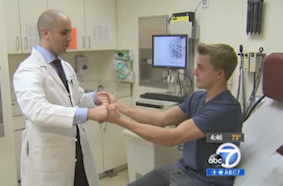New Concussion Guidelines For Young Athletes
SC CTSI-aided researcher discusses his research on ABC 7 News.
Note: USC researcher Gabriel Zada, MD, is currently an SC CTSI KL2 Scholar. As part of the program, he is acquiring and refining the core knowledge and skills needed to become a clinical translational investigator.
Previous head injury guidelines indicated young athletes could return to play if they were symptom-free, but new guidelines will include stronger precautions. Players will be required to sit out games even if they have a suspected concussion. New evidence supports these recommendations.
High school junior Brian Heintz knows a lot about tracking and tackling. As a linebacker for Flintridge Preparatory School, he takes a lot of hits. But a year and a half ago, it appeared he had taken one too many.

"I came out of the game because I actually had bleeding in my back as well as my head, so my legs, I had really sharp intense leg pain," said Heintz.
Gabriel Zada, MD, a neurosurgeon with Keck Medical Center of USC, immediately put Heintz on the sidelines. "Brian had slightly more than what we just call a normal concussion, because he actually had a very tiny rim of bleeding around the brain," said Zada.
Zada points to new evidence showing the significance of a single hit to the brain. "Even just one concussion or just one mild traumatic brain injury can cause long-term anatomical effects that we can see on the right kind of MRI," said Zada.
A report in the journal Radiology compared people with minor head injuries to those without. Those with the head trauma had nearly twice as much brain mass loss as the healthy volunteers and a higher incidence of mood disorders a year after the event. Zada says that includes anxiety, depression or problems with concentration.
Read more at Abclocal.Go.com
Learn more about the SC CTSI KL2 Scholar program



